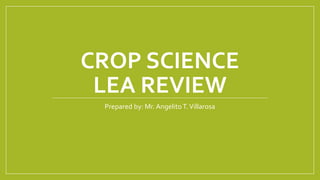This document contains a review exam for a Crop Science course. It consists of 56 multiple choice questions covering various topics related to crop science such as plant physiology, soil science, sustainable agriculture, seed science, and horticultural techniques. The questions assess understanding of concepts like photosynthesis pathways, transpiration, plant nutrition, effects of climate on crop growth, and components of sustainable crop production systems.



















































































































